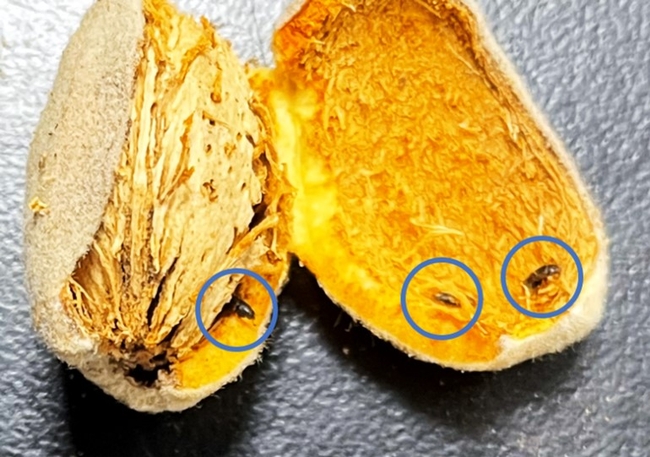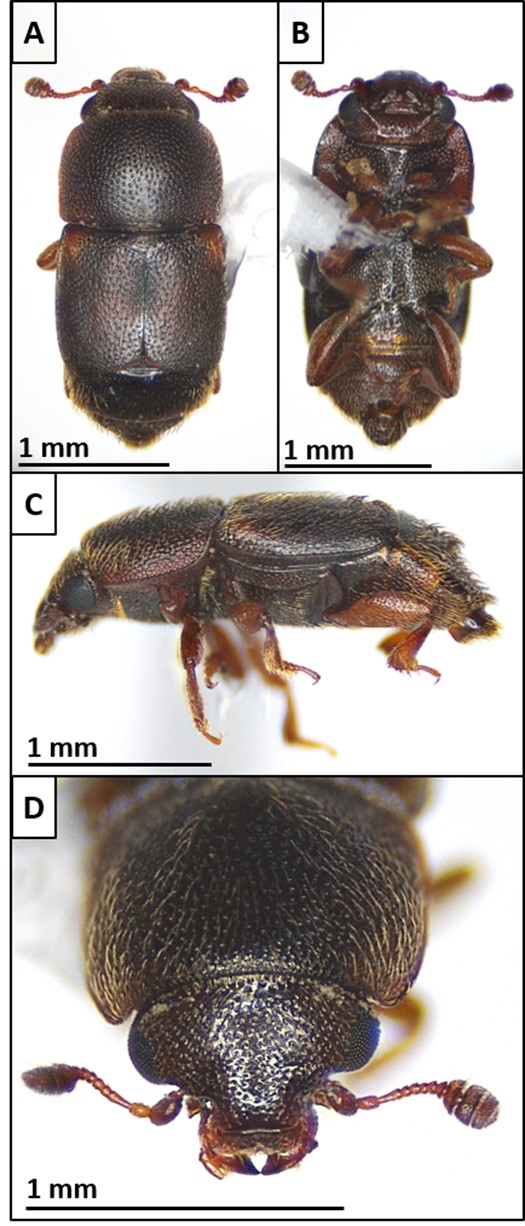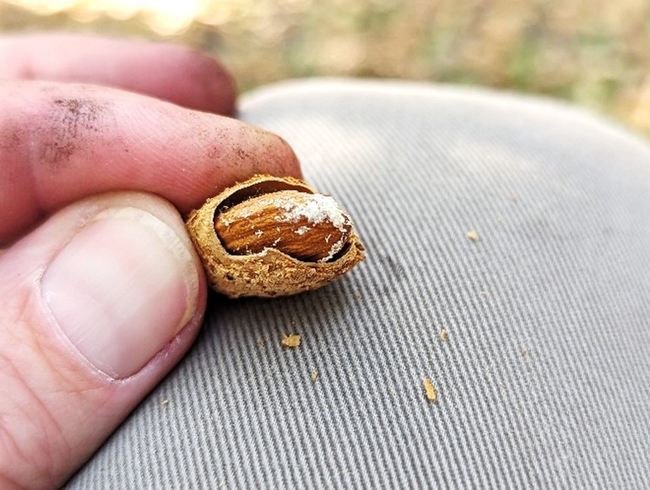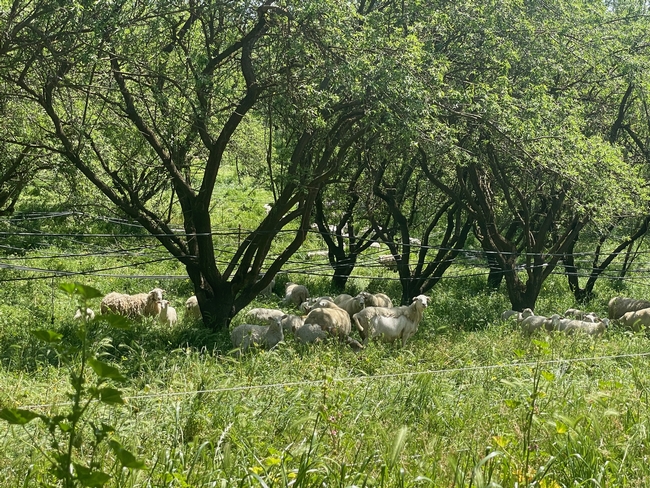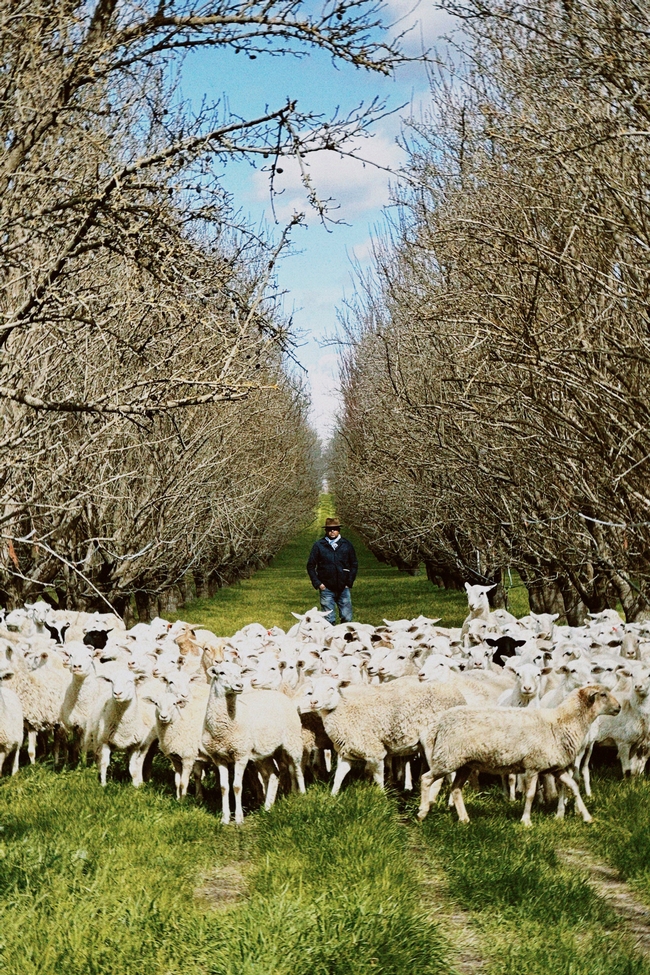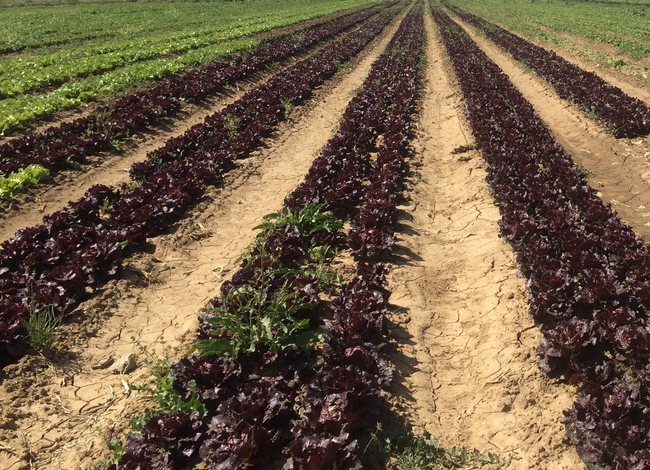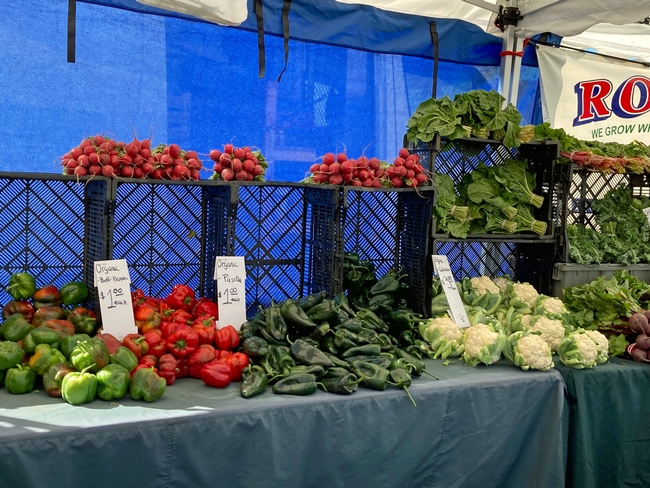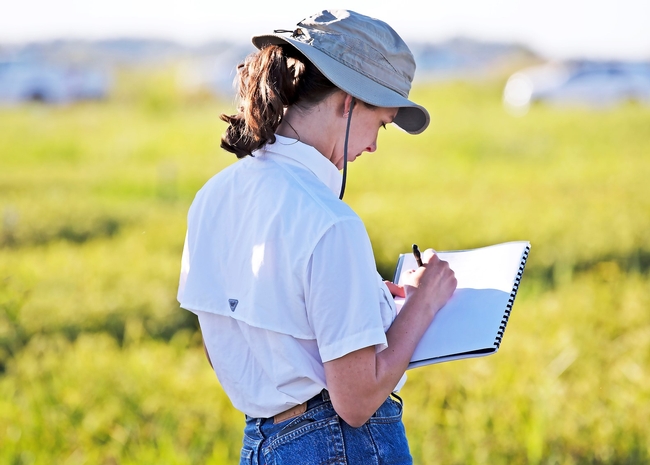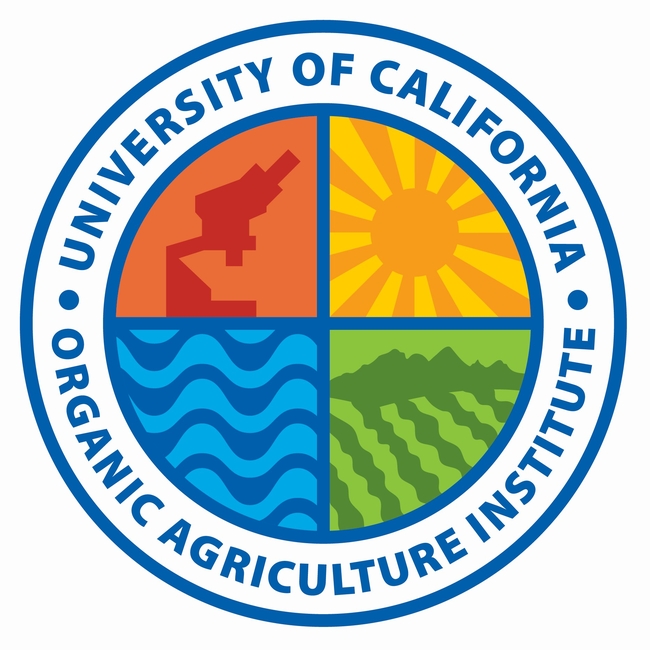Posts Tagged: Houston Wilson
New pest infesting almonds and pistachios in the San Joaquin Valley
Crop sanitation will be key to controlling the invasive carpophilus beetle
Growers and pest control advisers (PCAs) should be on the lookout for a new pest called carpophilus beetle (Carpophilus truncatus). This pest was recently found infesting almonds and pistachios in the San Joaquin Valley, and is recognized as one of the top two pests of almond production in Australia. Damage occurs when adults and larvae feed directly on the kernel, causing reductions in both yield and quality.
Populations of carpophilus beetle were first detected in September in almond and pistachio orchards by University of California Cooperative Extension Specialist Houston Wilson of UC Riverside's Department of Entomology. Pest identification was subsequently confirmed by the California Department of Food and Agriculture.
Wilson is now working with Jhalendra Rijal, UC integrated pest management advisor, North San Joaquin Valley; David Haviland, UCCE farm advisor, Kern County; and other UCCE farm advisors to conduct a broader survey of orchards throughout the San Joaquin Valley to determine the extent of the outbreak.
To date, almond or pistachio orchards infested by carpophilus beetle have been confirmed in Stanislaus, Merced, Madera and Kings counties, suggesting that the establishment of this new pest is already widespread. In fact, some specimens from Merced County were from collections that were made in 2022, suggesting that the pest has been present in the San Joaquin Valley for at least a year already.
“It has likely been here for a few years based on the damage we've seen," Rijal said.
This invasive beetle overwinters in remnant nuts (i.e. mummy nuts) that are left in the tree or on the ground following the previous year's harvest. Adults move onto new crop nuts around hull-split, where they deposit their eggs directly onto the nut. The larvae that emerge feed on the developing kernels, leaving the almond kernel packed with a fine powdery mix of nutmeat and frass that is sometimes accompanied by an oval-shaped tunnel.
Carpophilus beetle has been well-established in Australia for over 10 years, where it is considered a key pest of almonds. More recently, the beetle was reported from walnuts in Argentina and Italy as well. Carpophilus truncatus is a close relative to other beetles in the genus Carpophilus, such as the driedfruit beetle (C. hemipterus) that is known primarily as a postharvest pest of figs and raisins in California.
Monitoring for carpophilus beetle is currently limited to direct inspection of hull split nuts for the presence of feeding holes and/or larvae or adult beetles. A new pheromone lure that is being developed in Australia may soon provide a better monitoring tool for growers, PCAs and researchers.
“We're lucky to have colleagues abroad that have already been hammering away at this pest for almost a decade,” said Haviland. “Hopefully we can learn from their experiences and quickly get this new beetle under control.”
The ability to use insecticides to control carpophilus beetle remains unclear. The majority of the beetle's life cycle is spent protected inside the nut, with relatively short windows of opportunity available to attack the adults while they are exposed. The location of the beetles within the nut throughout most of their life cycle also allows them to avoid meaningful levels of biological control.
In the absence of clear chemical or biological control strategies, the most important tool for managing this beetle is crop sanitation.
“Given that this pest overwinters on remnant nuts, similar to navel orangeworm, crop sanitation will be fundamental to controlling it,” Wilson said. “If you needed another reason to clean up and destroy mummy nuts – this is it.”
In Australia, sanitation is currently the primary method for managing this pest. And here in California, new research and extension activities focused on carpophilus beetle are currently in the works.
“It's important that we get on top of this immediately,” said Wilson. “We're already starting to put together a game plan for research and extension in 2024 and beyond.”
If you suspect that you have this beetle in your orchard, please contact your local UC Cooperative Extension farm advisor (https://ucanr.edu/About/Locations/), County Agricultural Commissioner (https://cacasa.org/county/) and/or the CDFA Pest Hotline (https://www.cdfa.ca.gov/plant/reportapest/) at 1-800-491-1899.
USDA awards $2 million to study livestock grazing in organic orchards
UC, The Organic Center, University of Rhode Island partner on $3.5m food-safety study for organic produce growers
Grazing sheep and other livestock can help convert cover crops to fertilizer for orchard crops. To develop best management practices, the University of California and The Organic Center are collaborating on research to help organic orchard growers safely incorporate livestock grazing into their farming practices. The project is funded by a $2 million grant recently awarded through the U.S. Department of Agriculture's Organic Agriculture Research and Extension Initiative research program.
Interest in grazing livestock on cover crops in nut orchards has increased in recent years. However, research is needed to determine the best way to improve soil health and pest suppression, and to address concerns about food-borne pathogens and food safety.
“Organic farmers typically follow the USDA National Organic Program standards for raw animal manure, waiting 90 to 120 days between incorporating raw manure into the soil and harvesting the crop,” said Alda Pires, UC Cooperative Extension urban agriculture and food safety specialist in the School of Veterinary Medicine at UC Davis.
“Little research has been conducted to verify adequate waiting periods to reduce contamination risks in integrated crop-livestock production systems,” she said. “This research will fill the knowledge gap and facilitate the development of science-based food safety guidelines for grazing small ruminants in orchards.”
For this four-year project, “Influence of Orchard Grazing on Soil Health and Pest Control While Mitigating Food Safety Risk,” the scientists will study organic almond, walnut and pistachio orchards in two distinct nut-growing regions in California – the Sacramento Valley and San Joaquin Valley. The scientists will assess the effects of livestock grazing of cover crops on bacteria populations, soil health, pest control and economics.
Building soil health
“Growers have consistently raised the need for more information on grazing impacts on nutrient availability during tree growth, as well as potential to build up the biological, physical and chemical pillars of soil health,” said Amelie Gaudin, associate professor and endowed chair of agroecology in the UC Davis Department of Plant Sciences.
Livestock grazing may provide an opportunity to quickly enhance the amount of nitrogen that can be used by plants and microbes when the cover crop is terminated. “This project will help growers develop nitrogen budgets for these more diversified systems and quantify additional benefits and potential tradeoffs for soil health – such as compaction and salinity – to guide the development of place-based best management practices,” Gaudin said.
Pest management
Houston Wilson, UC Cooperative Extension specialist in the Department of Entomology at UC Riverside, will be studying the effects of livestock grazing on orchard pests.
“Navel orangeworm, or NOW, is by far the most destructive pest of almonds and pistachios,” Wilson said. “These moths overwinter in unharvested nuts in the orchard, and so removal and destruction of remnant nuts over the winter is the foundation of NOW control. While farmers typically use machinery to do this, grazing with animals may present a unique alternative that is more cost-effective and provides additional ecosystem benefits, such as soil health and weed control.”
Outreach to farmers
As part of the project, The Organic Center was awarded $75,000 to work with UC Agriculture and Natural Resources to direct national extension and education outreach activities. These will include a social media campaign, webinars and educational sessions and a technical report for growers.
“There is an increasing interest from organic farmers to learn how to incorporate livestock into their operations to gain better soil health and fertility,” said Amber Sciligo, director of science programs at The Organic Center.
“This research is very exciting because it will holistically explore the potential risks and benefits of livestock not just to soil health, but also pest control – a truly interdisciplinary project that matches the whole system of the organic farm.”
Produce food-safety management tools
For another organic food-safety project, Pires and Sciligo will be working with Patrick Baur, professor of Sustainable Agriculture and Food Systems at the University of Rhode Island.
The University of Rhode Island and The Organic Center received $3.5 million from USDA's Organic Agriculture Research and Extension Initiative research program for the new organic food-safety education project.
“We're going to develop a new food safety management tool designed specifically for organic soil amendments,” said Baur, who is leading the project. “We're also going to develop a suite of new communication and training tools aimed at the entire fruit and vegetable sector to build a shared language between organic agriculture and the food safety community and help them work better together.”
As part of the produce project, Pires of UC Davis was awarded $1.16 million to conduct a risk assessment and create a publicly accessible dashboard to meet the specific needs of organic growers operating at different scales, under different cropping systems, in different regions.
Also participating in this project will be Beatriz Martinez Lopez, professor in the School of Veterinary Medicine at UC Davis, and Abhinav Mishra and Govindaraj Dev Kumar of the University of Georgia.
Organic farmers to get technical assistance from CDFA and UC ANR
The California Department of Food and Agriculture is awarding $1.85 million to the University of California Agriculture and Natural Resources to increase technical assistance for California's organic farmers.
CDFA's State Organic Program is executing $850,000 in contracts with UC ANR to run through September 2024, while CDFA's Office of Environmental Farming and Innovation is awarding a $1 million grant to run from July 2022 to June 2025.
“California farmers provide 36% of all organic production in the United States,” said CDFA Secretary Karen Ross. “This funding expands technical assistance to growers transitioning to certified organic agriculture and supports our strong California community of organic farmers and consumers by conducting field trials and demonstration projects with farmers to improve organic practices.”
California organically farms just over 2 million acres, which is about 8% of the total agricultural acreage in the state, and will likely continue to expand over time as long as consumer demand continues to rise, according to Houston Wilson, director of UC ANR's Organic Agriculture Institute.
“Demand for organic agriculture has consistently grown every year for the past two decades,” Wilson said. “Organic currently accounts for 5.8% of domestic food sales.”
“We are excited to see CDFA increasing support for organic agriculture as part of a broader climate-smart agriculture strategy,” said Wilson. “As demand for organic continues to rise, California growers need increasingly targeted technical assistance in all areas of organic production and marketing.”
The CDFA funds will allow UC ANR to hire two academic coordinators, which are currently being recruited.
“The academic coordinators will work directly with growers, as well as develop research and extension projects that will involve existing UC Cooperative Extension personnel,” Wilson said. “One of the coordinators will specifically focus on connecting our efforts with small-scale and historically underserved growers through our partnership with the UC Small Farms Program.”
The organic practices can be used by conventional farms as well as organic farms.
“Just as organic farmers benefit from UC ANR's pest management, irrigation and crop production research, the new knowledge developed on organic practices by the UC Organic Agriculture Institute will be useful for all California farmers,” said Glenda Humiston, UC vice president for agriculture and natural resources.
Some of the key UC ANR project objectives include:
- Conduct research on soil health management, carbon sequestration and crop rotations in organic systems
- Create new extension and training opportunities for organic growers across California
- Provide technical assistance to both certified and transitioning organic growers
- Review and summarize organic acreage and practices in California
- Develop economic analysis of organic production and markets
“Clif Bar is proud to have supported the creation of the UC Organic Agriculture Institute and congratulates them on this new and important funding,” said Philippa Lockwood, Clif Bar social responsibility program manager. “Supporting the advancement of organic agriculture in our home state of California and the great work that's to come from the UCOAI is a true honor and we look forward to their impactful agricultural innovations ahead.”
The 2022-2023 state budget signed last week by Gov. Gavin Newsom includes $5 million in funds for CDFA to assist farmers with transitioning to organic operations, and the USDA recently announced an investment of up to $300 million for the same purpose.
Updated July 18, 2022, to add Philippa Lockwood quote.
New California Organic Research Agenda available online
Organic Farming Research Foundation (OFRF) has published the new California Organic Research Agenda (CORA), a comprehensive report that examines current needs and challenges of organic farmers and ranchers across California and provides policy and research recommendations to address producer-identified issues.
The CORA report is a companion to OFRF's 2022 National Organic Research Agenda. The national organic survey data boasts responses from over 1,100 producers and 16 listening sessions held across the U.S. Using the California subset of the national survey data, the CORA report highlights the top production and non-production challenges cited by California's organic farmers and ranchers.
“Organic farming has been historically under-invested in, in terms of research, education and extension,” says OFRF Executive Director Brise Tencer. “Both the new California Organic Research Agenda and the 2022 National Organic Research Agenda present incredible feedback directly from organic farmers and provide a compelling roadmap for how to best support the growth of this important sector of agriculture.”
Report findings indicate that managing production costs is a substantial challenge for 71% of producers surveyed, and accessing labor proved to be the leading non-production challenge. An overwhelming number of state producers (76%) expressed substantial need for technical assistance with the organic management of weeds, pests, and disease. In addition to detailing farmer challenges on and off the field, OFRF's CORA report provides a comparison analysis of farmer responses based on commodity and farming experience. National and state comparisons are also included in the report.
Production of the CORA report was supported in part by the University of California Organic Agriculture Institute, a new statewide program within the UC Division of Agriculture and Natural Resources, as well as the UC Santa Cruz Center for Agroecology.
“One of our primary activities is to generate new research and extension programs focused on organic agriculture,” says Houston Wilson, director of the UC Organic Agriculture Institute. “The CORA report provides an excellent roadmap to guide and prioritize our efforts, we're really excited to turn this information into action.”
According to the California Department of Food and Agriculture, state farmers and ranchers were responsible for 40% of all organic agricultural product sales in the country. Data from a 2019 USDA organic survey concludes California has 965,257 acres in organic production, which is approximately 17.5% of all organic acreage in the country. OFRF's California Organic Research Agenda examines grower needs in the nation's top-producing state of organic agricultural commodities and specialty crops, paving the way for future research and investment.
"This report will benefit organic growers in California by playing a role as a critical reference to increase public support and develop research projects targeting specific needs that diverse organic growers in the state are facing," says Joji Muramoto, UC Cooperative Extension organic production specialist based at UC Santa Cruz.
The CORA report is available free online at https://ofrf.org/research/nora for farmers, policymakers, agricultural suppliers, seed companies and the general public.
Organic Ag Institute begins forming knowledge network, assessing needs
Cal OAK Network to build on, grow connections between UC and organic community
After pioneering the organic movement in the 1970s, California now leads the nation in number of organic farms, total organic acreage and overall organic crop value. Attaining this status was no small feat, and largely driven by resourceful growers who developed and refined the wide range of novel organic farming practices seen in California today.
Now, with the creation of the Organic Agriculture Institute, the University of California will be able to leverage its vast capacity for research, extension and education to further improve the sustainability, resilience and profitability of organic agriculture in the state.
In its first major public initiative, the Organic Agriculture Institute – a program of UC Agriculture and Natural Resources – is conducting a statewide needs assessment for organic agriculture, as well as forming a knowledge-sharing network that connects UC experts with growers, processors, producer organizations, certifiers, crop consultants, community groups and state agencies.
“This network will be a sustainability partnership that enables learning, innovation and cooperation among organic agriculture stakeholders,” said Houston Wilson, director of the Organic Agriculture Institute, which was established in January 2020. “As facilitator of the Cal OAK Network, the Organic Ag Institute will serve as an intermediary that fosters communication among stakeholder groups, organizes discourse, forges new collaborations, and generally enhances coordination of stakeholder activities.”
By creating closer connections between the UC and the organic community, the Cal OAK Network will foster ongoing feedback cycles of knowledge and best practices, and in doing so help create the conditions and momentum to facilitate the development and adoption of organic production practices.
“The Cal OAK Network will better connect the organic community with UC technical and training resources, while at the same time providing a mechanism for that community to feed information back to the UC that helps us shape our programs at the Organic Ag Institute,” said Wilson, noting potential contributions in areas such as pest control, weed management and crop nutrition.
In the first 18 months of the Institute, Wilson has been charting the current landscape of organic agriculture in California, listening to the needs of stakeholders and working to position the Institute in a way that best uses the UC's unique research and extension capacities to support and augment existing efforts by growers and other groups.
The Institute recently received a planning grant from the National Institute of Food and Agriculture to conduct a formal needs assessment through summer 2022. In surveying growers and other stakeholders, the Institute seeks to identify their primary research and extension priorities, as well as gain a better understanding of the key people and organizations they currently rely on for information about organic production.
Through this process, a map of nodes and connections in the organic community will also take shape – and the roster of members for the Cal OAK Network will continue to grow. As Wilson points out, it is only through a diverse and robust information-sharing system that California organic agriculture will successfully adapt to challenges like climate change.
“We're trying to create a resilient infrastructure for engagement with organic stakeholders,” he said. “When we talk about sustainability in agriculture, part of that is having sustainable institutions that function well and can be flexible and dynamic as new challenges arise down the road.”
To learn more about and join the California Organic Agriculture Knowledge Network, visit organic.ucanr.edu and contact Wilson at hwilson@ucanr.edu.

